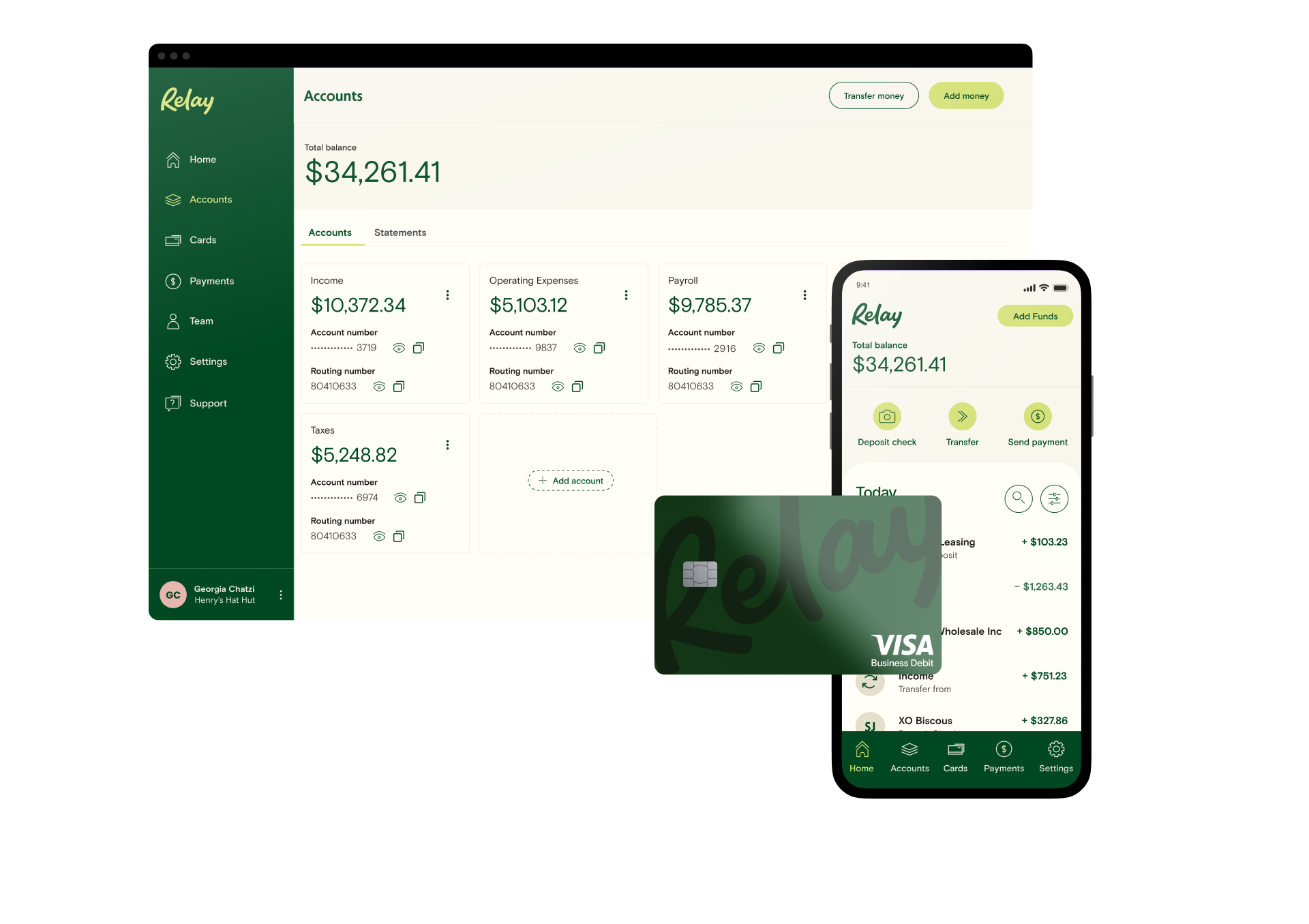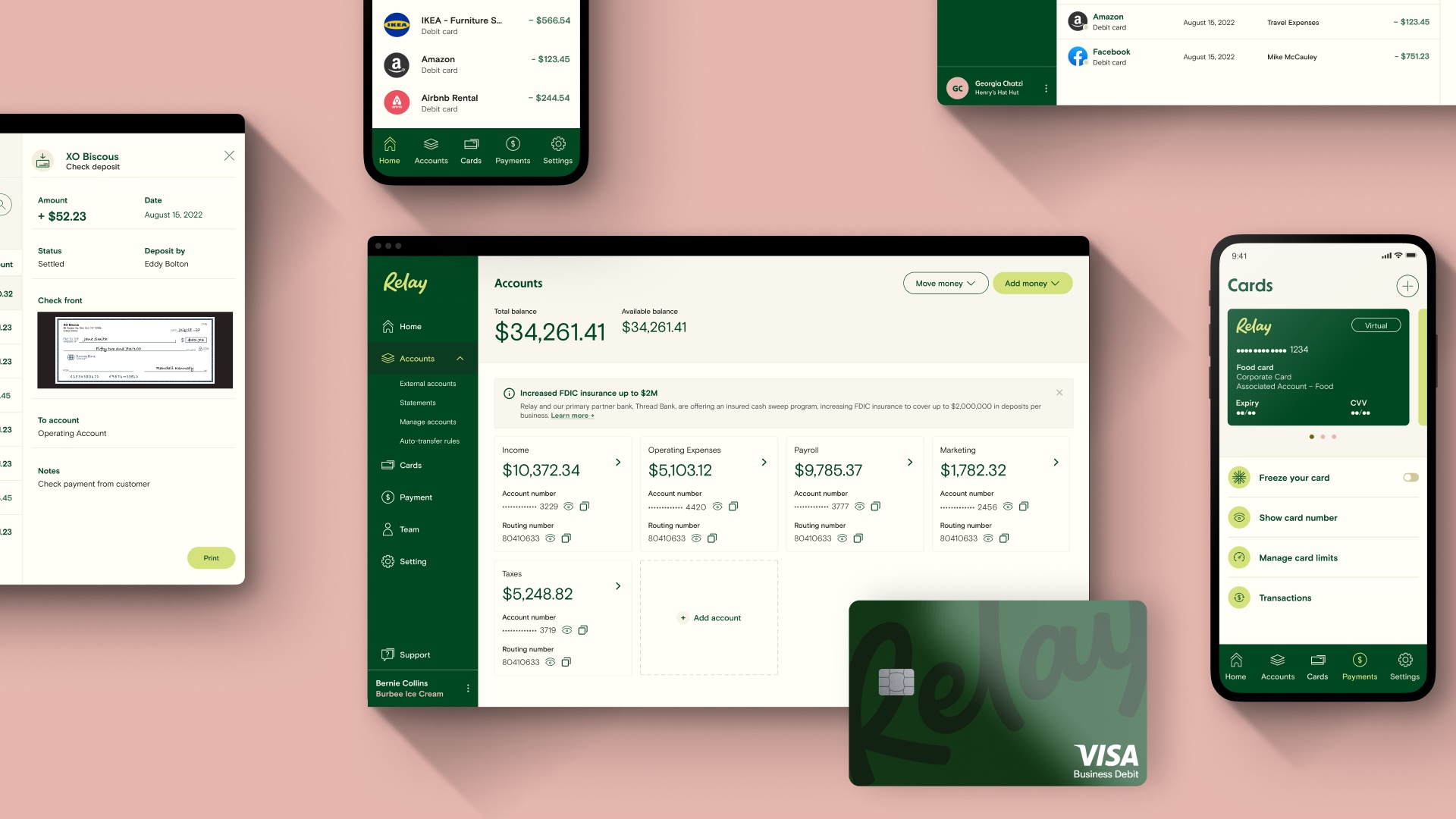Accounts payable (AP) automation is the process of simplifying, speeding up, or completely replacing all the manual work that goes into paying bills and vendor invoices with the use of AP software. It removes a huge chunk of administrative work from your day, while ensuring that bills are paid accurately and on time. 👏
At Relay, we simplify online bill pay for small businesses by integrating AP directly into online banking. 🔄 It's the right approach for businesses who want benefits like faster settlement times or the option to manage all payments from one place.
In this guide, we'll share a real workflow example of how you can use Relay together with an accounting platform called Dext to completely automate your bill pay. Let's dive in!
What is accounts payable (AP)?
Accounts payable (AP) is the process of managing outstanding debts owed to creditors for goods or services rendered. For example, when a vendor agrees to be paid later instead of right away, the money you now owe them becomes an outstanding bill, part of “accounts payable”. The process of managing those bills is also known as AP and may include contractor wages, inventory costs, rent, and everything else in between.
Go deeper: Understand the difference between ACH vs wire transfers >
AP is how money leaves your business, so it’s important to maintain strong internal controls to eliminate the risk of errors or fraudulent activity.
What are the steps in accounts payable?
The accounts payable process can be broken down into five (5) steps:
Receiving invoices and making sure they are entered into your system correctly
Organizing, reviewing, and processing invoices
Approving invoices through the right channels
Paying the invoices on time
Reconciling paid invoices in your accounting system
When managed correctly, a strong AP process can help you unlock access to cash and give you more visibility into cash flow. 🔍 For example, consider the impact on a business's cash flow if a vendor agrees to receive payment 30 days later than usual. By unlocking that cash for another month, a business can add an entire sales cycle before it has to cover inventory costs.
However, optimizing your cash flow is challenging when you have a manual AP process. This becomes clear once you take a closer look at each step of processing an invoice. In the next section, we’ll do just that. 👇
What can go wrong with a manual accounts payable process?
A manual AP process creates three main issues for a business: it increases the potential for payment errors, results in more time wasted on administrative tasks, and it can damage relationships with vendors.
AP automation is an opportunity for businesses to streamline this process and gain clearer cash flow visibility, reduce administrative work, and minimize AP errors.
Here's how AP is handled when it's done manually:
1. Invoices are received through email or paper
With most manual processes, there is no set process in place, and vendors choose how to send you their invoices. That means you receive invoices through multiple channels — emails, faxes, maybe even physical copies.

2. Invoice data is manually transcribed
Once an invoice reaches your business, someone on your team has to verify its accuracy. Next, invoice data must be manually entered into the internal payment processing system. 📝 After payment has been made, the invoice codes need to be manually inputted into the general ledger.

When businesses have to enter invoice data manually, deal with varying invoice formats, juggle multiple due dates, and follow up with multiple approvers internally, the risk of lost invoices and payment errors increases.❗
3. No formal invoice approval process
Before an invoice is paid, it needs to be approved. But in most small businesses, there's no formal invoice approval process. As a result, the AP process requires manual follow-up and takes much longer than necessary. Or worse, invoices may get paid without going through any approval process at all, potentially leading to costly errors. 🙅

When you factor in manual data entry, follow-ups with vendors, and informal or non-digitized approval workflows (i.e. paper invoices being reviewed by an approver — or approvers — in person), it's easy to understand why traditional invoice processing is slower and easily delayed. 🐌
4. Invoices paid by writing a check
For many small businesses, AP involves a staff member physically preparing a check. Then, they must track down someone (like the business owner) to get that check signed. The check is then mailed 📨 to the vendor, and the books are manually reconciled.

When you manage invoices manually, the risk of delays and human errors ❌ can make it difficult to set appropriate expectations for vendors and stick to them. This may damage your vendor relationships, and you may miss out on favorable payment terms as a result.
What does manual AP cost a business?
One study reveals that the average processing cost for a single invoice can be up to $15. 😮 And the average processing time — from when the business receives an invoice to when payment approval and submission takes place — can be as long as 45 days.
What is AP automation?
AP automation is the process of streamlining accounts payable to significantly enhance productivity and free up cash. 🙌 When your business payments are automated, a digital tool can simplify or even completely take over the accounts payable tasks on your behalf.
AP automation can address one or more steps of the accounts payable cycle, like processing, approvals, or payments. In most cases, while certain AP processes are automated and streamlined, the entire system is still managed by a team member, accountant, or bookkeeper. 💪
Here are some of the most common types of accounts payable technologies available to small businesses:
Automated invoice processing
Instead of logging information from a paper invoice manually, you can have vendors submit their bills electronically 🌐 to an invoicing platform which then sorts out those bills automatically. Alternatively, you can also use a tool to scan invoices, extract key information (like amounts and vendor information), and automatically sync that information with your accounting system
Automated approval workflows
Those responsible for invoice approvals can receive automated emails 📧 and reminders to 🔔 review and approve bills electronically rather than in person, saving everyone from unnecessary follow-ups.
Digital payments
Paying invoices by wire, ACH, or same-day ACH (rather than by check) drastically shortens the payment timeframe. What's more, if you use an AP platform that syncs with your accounting software (think: QuickBooks Online or Xero), you can save time on bookkeeping by automatically marking those invoices as paid in your system. ✅
Key benefits of AP automation
Research shows that automation creates both immediate and long-term advantages for your business. These include:
Faster approval of invoices
Improved visibility of unpaid invoices
Increased employee productivity
Better adherence to your accounts payable internal controls
Fewer late payment penalties
Early payment discounts
Improved relationships with your suppliers
Lower AP processing costs overall
How can automation create savings for a business?
While the average processing cost for one invoice can be as high as $15 — with automation, the average cost can drop to as little as $1.77. 👏
With best-in-class AP automation, you can reduce the average invoice processing time of 45 days down to as little as 3 days 👀
What does an automated AP workflow look like?
Here’s an example of an efficient and cost-effective automated payment process that combines two AP systems:
Dext, an invoice management platform for bill receipt and processing; and
Relay, a money management platform for approval workflows, payments, and immediate bill pay reconciliation.

This automated payables workflow simplifies and streamlines the full AP cycle. Here's how:
1. Invoices received through Dext
Vendors send in either digital, faxed, or physical invoices to the business. Using Dext, all of the invoices are automatically digitized. 💻
2. Invoice data processed from Dext to accounting
All key invoice information, like payment amounts, dates, taxes, payees, and line items get processed through Dext. This gets sent to the accounting system, like QuickBooks Online or Xero, and goes to the appropriate chart of accounts. 📊
3. Manage approval workflows in Relay
Once the invoice data is input into the accounting system, Relay automatically pulls that data into its bill pay module, along with the associated invoice file. Authorized team members can check relevant outstanding invoices, and submit them for approval inside Relay. This kicks off a notification to the relevant approver(s) that a bill needs attention. 📣
4. Paid invoice with Relay's same-day ACH, wire, or check
Once all approvers confirm that an invoice is ready to be paid, the payment can be initiated directly from the business's checking account. The payment can be made through a wire, same-day, business-to-business ACH, or by check that gets automatically sent to the payee's address. 🙏
Now that you are armed with a strong understanding of how the AP process works — both manually and with automated support — and have an ideal AP automation workflow to reference, you’re ready to continue on your AP automation journey.
Banking Built for Business Owners
No account fees or minimums; 20 checking accounts; 2 savings accounts with 1.00%-3.00% APY; 50 virtual + physical debit cards. Open account 100% online.
Learn moreAs you explore your options, make sure to check out Relay's money management platform and learn how it can automate your AP process.





